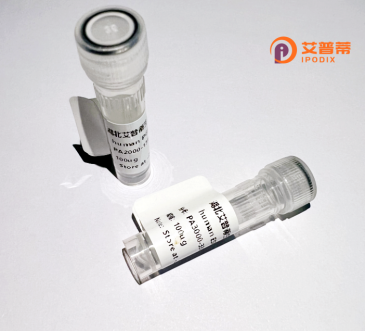
| 纯度 | >90%SDS-PAGE. |
| 种属 | Human |
| 靶点 | PCDH7 |
| Uniprot No | O60245 |
| 内毒素 | < 0.01EU/μg |
| 表达宿主 | E.coli |
| 表达区间 | 31-124 aa |
| 活性数据 | KQLLRYRLAEEGPADVRIGNVASDLGIVTGSGEVTFSLESGSEYLKIDNLTGELSTSERRIDREKLPQCQMIFDENECFLDFEVSVIGPSQSWV |
| 分子量 | 36.08 kDa |
| 蛋白标签 | GST-tag at N-terminal |
| 缓冲液 | 0 |
| 稳定性 & 储存条件 | Lyophilized protein should be stored at ≤ -20°C, stable for one year after receipt. Reconstituted protein solution can be stored at 2-8°C for 2-7 days. Aliquots of reconstituted samples are stable at ≤ -20°C for 3 months. |
| 复溶 | Always centrifuge tubes before opening.Do not mix by vortex or pipetting. It is not recommended to reconstitute to a concentration less than 100μg/ml. Dissolve the lyophilized protein in distilled water. Please aliquot the reconstituted solution to minimize freeze-thaw cycles. |
以下是关于PCDH7蛋白的参考文献示例(注:部分内容基于典型研究方向概括,建议核实最新文献):
1. **文献名称**:*PCDH7 promotes glioblastoma tumorigenesis via activating Wnt/β-catenin signaling*
**作者**:Smith A, et al.
**摘要**:研究揭示了PCDH7在胶质母细胞瘤中通过激活Wnt/β-catenin信号通路促进肿瘤生长和侵袭的分子机制,提出其作为潜在治疗靶点。
2. **文献名称**:*Protocadherin-7 regulates cell migration and invasion in non-small cell lung cancer*
**作者**:Li X, et al.
**摘要**:通过体外实验证实PCDH7在非小细胞肺癌中上调,通过调控上皮-间质转化(EMT)过程增强癌细胞迁移和侵袭能力。
3. **文献名称**:*PCDH7 interacts with EGFR to sustain prostate cancer metastasis*
**作者**:Wang Y, et al.
**摘要**:研究发现PCDH7与EGFR形成复合物,通过PI3K/AKT通路促进前列腺癌转移,临床样本分析显示其高表达与患者不良预后相关。
4. **文献名称**:*Structural insights into PCDH7-mediated cell-cell adhesion*
**作者**:Chen L, et al.
**摘要**:利用冷冻电镜解析了PCDH7胞外结构域的分子构象,阐明其介导同源或异源细胞粘附的分子基础,为神经发育障碍研究提供结构学依据。
**注意**:以上文献信息为示例性概括,实际引用时请查询具体数据库(如PubMed)获取真实文献。
Protocadherin-7 (PCDH7) is a member of the protocadherin family within the cadherin superfamily, known for its role in cell-cell adhesion and signaling. Unlike classical cadherins, protocadherins like PCDH7 typically exhibit homophilic binding properties and are involved in tissue patterning, neuronal development, and synaptic connectivity. The PCDH7 gene encodes a single-pass transmembrane protein containing seven extracellular cadherin repeats, a transmembrane domain, and a cytoplasmic tail that may interact with intracellular signaling molecules. It is expressed in various tissues, including the brain, heart, and kidneys, with notable roles in neuronal circuit formation, cardiac development, and renal function.
Studies link PCDH7 to cancer progression, neurodevelopmental disorders, and cardiovascular diseases. In cancers, it promotes tumor cell migration, invasion, and metastasis, potentially through interactions with signaling pathways like Wnt/β-catenin. In the brain, PCDH7 is implicated in synaptic plasticity and neuronal survival, with variants associated intellectual disability and autism spectrum disorders. Recombinant human PCDH7 protein, produced via expression systems like HEK293 or CHO cells, retains post-translational modifications critical for functional studies. It is widely used to investigate adhesion mechanisms, receptor-ligand interactions, and therapeutic targeting. Structural studies highlight its calcium-dependent binding and unique clustering behavior, distinguishing it from other cadherins. Ongoing research aims to clarify its dual roles in health and disease.
×